What Can You Feed Wild Cranes
Sandhill Cranes (Antigone canadensis) are omnivores, like most other birds. However, their preferred foods are grains and insects.
Cranes can probe into the ground, searching for their food using their long, narrow beak.
Even with their preferences, Sandhills will also eat reptiles, amphibians, rodents, berries, tubers, vegetation, and nearly anything else they can swallow.
The short answer of what Sandhill Cranes eat is not quite as fascinating as towhy they prefer these two primary food sources.
Carbohydrates are good for quick bursts of energy and can help the birds pack on fat before migrations. In addition, the protein found in insects is vital to the rapid development of young birds and maintaining and repairing healthy muscles in adults.
Let's look a little closer at those essential food sources these magnificent birds utilize.
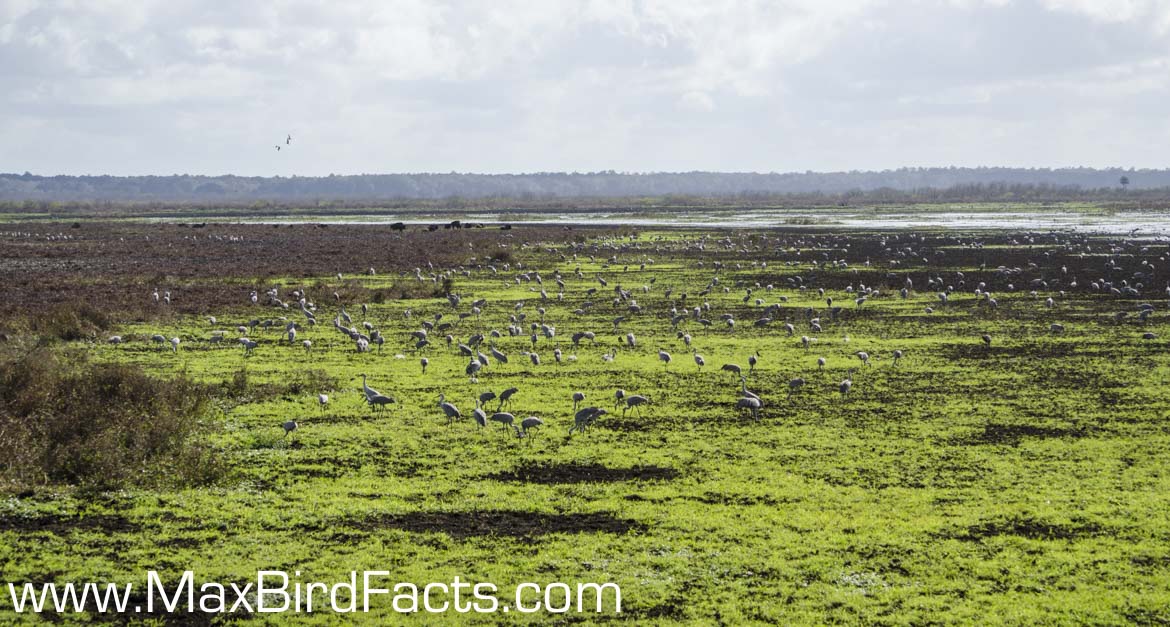
Grains – Carbohydrates Power the Greatest Migration of North America
Carbohydrates are a crucial part of a Sandhill Crane's diet. They make up the bulk of their caloric intake and provide most of the energy these birds use when migrating.
During the spring migration, Sandhill Cranes will pass through the Platte River Basin in central Nebraska. The Platte is an agriculturally rich zone in the United States, providing wheat, corn, and soy to the entire country.
Farmers will often have spillage of their crops during harvest, and the cranes are delighted for it.
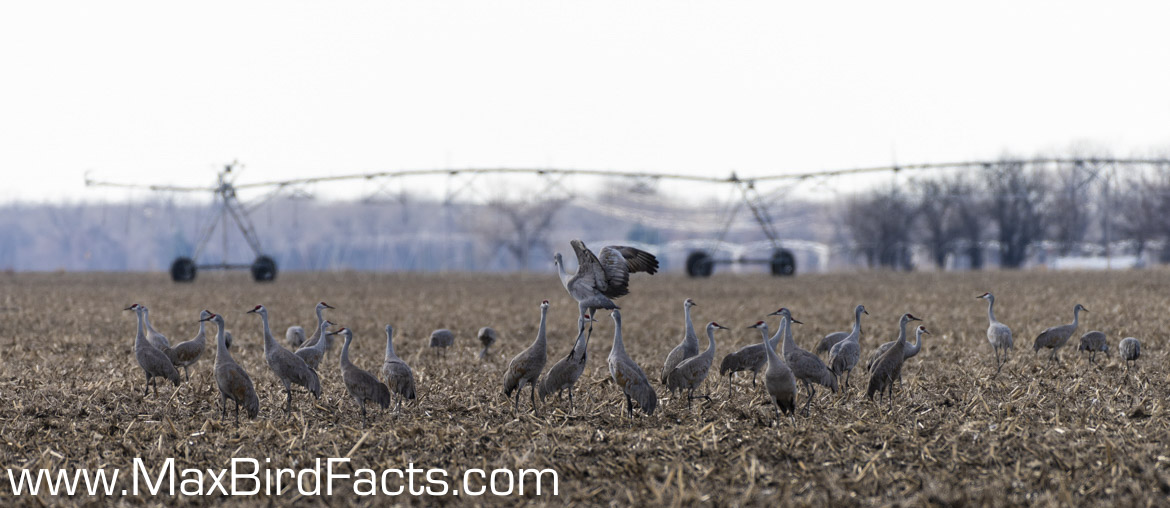
Sandhill Cranes have been taking advantage of the Platte River Basin long before humans used it for agriculture. Fossils dating back approximately 10,000 years place these birds at the Platte.
So if there wasn't all this fattening grain during the Mesolithic, why were the cranes going there?
The biggest draw for the cranes to this region is the Platte River itself. Its relatively shallow, slow-moving waters are perfect for the cranes to flock to at night.
Sandhill Cranes have lost the ability to perch, and this was the cost of having feet supremely designed to walk on Earth.
Because of the loss of their rear toe, Sandhill Cranes are forced to sleep on the ground. This can be very dangerous, but sleeping in shallow water was their solution.
Sleeping in water might sound odd, but it is the safest place to sleep on the ground (maybe except for Florida). If the water is disturbed by a potential predator, the cranes will be alerted and fight or flee.
I won't go too deep into the reasoning here, but if you want to read more about why Sandhills lost their hind toe, check out my articleWhere Do Sandhill Cranes Sleep – Lost Toes and Frigid Rivers.

During the Mesolithic, the open fields and grasslands were an added benefit to the perfect nightly accommodations. These tall birds could walk through the grasses, picking off insects and seeds as they marched.
Standing erect on sturdy legs at nearly five feet tall and having incredible eyesight, they can spot a predator easily. It's hard to know exactly why these ancient cranes decided to call the Platte their home.
Still, I think it was mainly because of its near-perfect placement between their winter and summer ranges, as well as the tailored fit the river filled for their need to sleep.
With the advent of modern agriculture, Sandhill Cranes flock in the hundreds of thousands through the Platte every migration.
In our diet, grains and carbohydrates make the base of a healthy diet. I'm sure you've seen a food pyramid at some point, where carbohydrates like bread, pasta, and rice form the base.
Modern diets like Keto and Paleo denounce this and push for a low or nearly no carbohydrate intake. I've personally done both of these diets, and they do have their merit.
Switching your body to run off fat is a fantastic way to "hack" your metabolism and lose weight. That said, I don't think these ultra low carb diets are healthy in the long term.
I strongly believe in everything in moderation, and our bodies require proteins, fats, and carbohydrates. However, it is very well known that an excess of carbs in your diet will lead to more body fat.
For modern humans, this can pose some health issues. But, for our hunter-gatherer ancestors, this was a phenomenal advantage.
Fat is how the body stores energy long-term while still being easily accessible.

For example, if an ancient human came upon a berry bush and could eat more calories than they would use, those extra calories would be turned into fat reserves. Those extra calories from the berries could be enough to save that human through a leaner day where they don't consume the same amount of calories as they burn.
This is precisely what the Sandhill Cranes are doing. The cranes walk up and down the cornrows looking for spilled grain, and they can consume far more calories than they burn.
All of this excess is turned into fat, just like with our berry-eating human. This fat is vital to the success of the crane's migration. If they can't pack on the pounds, the bird won't have enough energy to make the entire trip.
Sandhill Cranes fly an average of 250 miles a day, and this requires a lot of energy.
And this need for fat isn't just seen with Sandhill Cranes; all migratory birds require this. After a bander catches a bird, they will softly blow on the ventral aspect of the bird (belly, breast, underwing, etc.).
They are separating the feathers with their breath to see if the bird has fat stores. This fat will tell the bander if the bird is ready to leave, passing through, or staying for the season.
Sandhill Cranes will gorge themselves in the fields surrounding the Platte River.
All of this feasting will gain them approximately 3 pounds of fat, that's around 30% of their total body weight!
But don't worry, the cranes won't have to try and jog it off throughout the year because the last 2,000 miles or so of flying north will burn nearly all of that fat away.
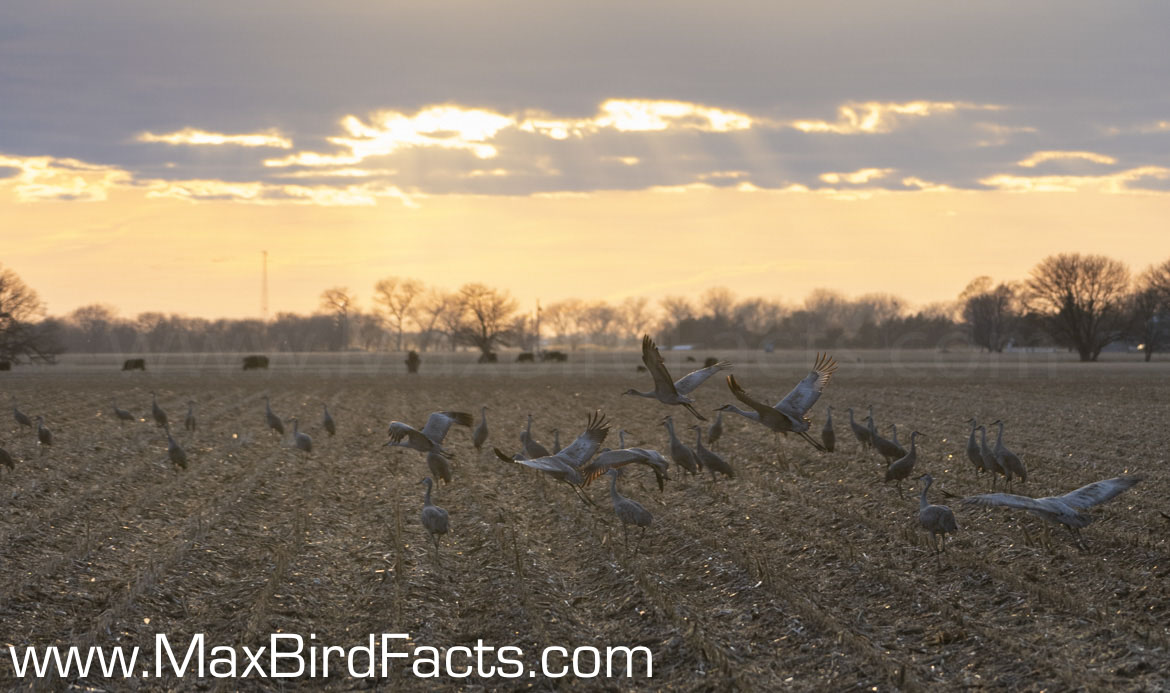
Insects – Protein-Packed Snacks to Grow Up Fast
Insects are one of the most protein-dense sources of food available. Ounce for ounce, a worm has nearly three times the protein in it compared to a steak. Now, I'm not saying I'm replacing my steaks for worms, but I can see why a bird would.
Insects are relatively small and usually don't pose much of a threat to a bird when being harvested, making them ideal prey items.
During the nesting season, parents will forage for insects to bring back to their chicks. Some birds will make hundreds of trips to and from the nest each day to provide their voracious young.
All of these bugs are necessary for the rapid development these chicks undergo.
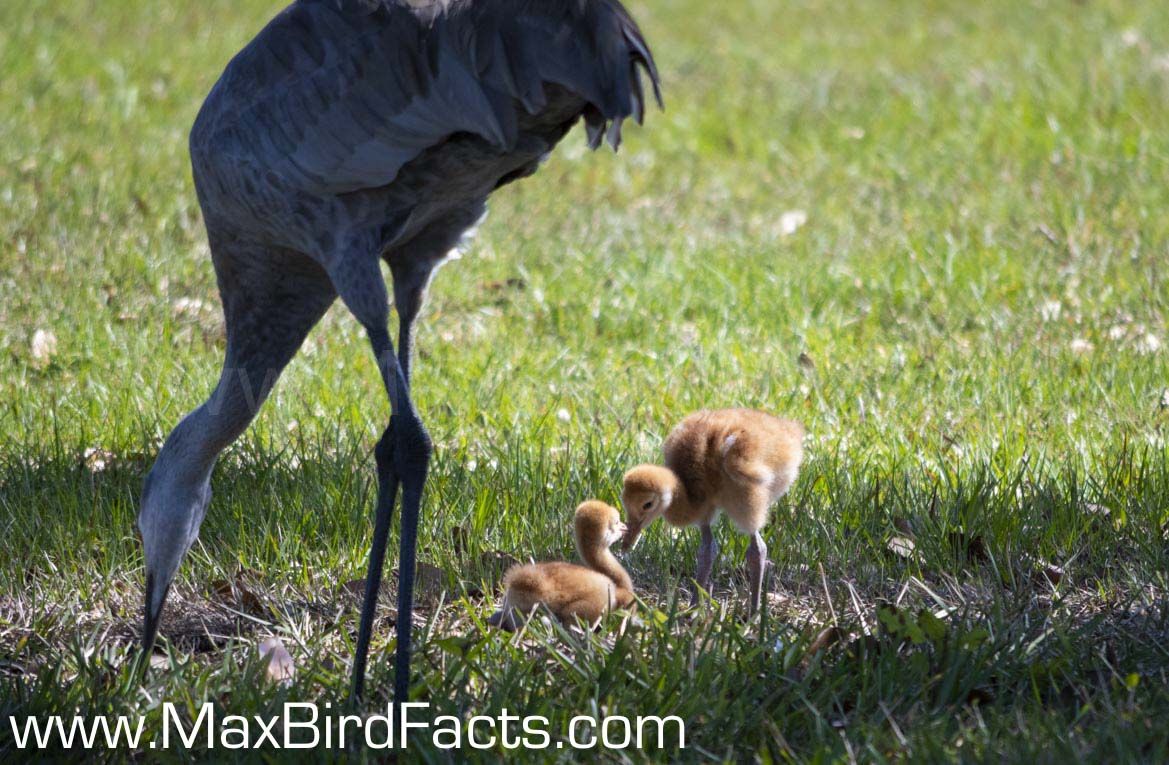
Sandhill Crane chicks areprecocial, meaning they are born ready to run. Similar to horses, gazel, and deer, newly hatched crane chicks can get to their feet very soon after coming into the world.
I believe this is the reason baby cranes have been given the nickname "colts." Their ability to run right after hatching is akin to a foal standing right after being born.
I would even say the fluffy, downy feathers of the hatchling cranes remind me of the tawny color many young horses have while they are young.
Anyways, Sandhill Crane colts require a lot of protein to build muscle during their short developmental phase.
The colts wander around the nest site, searching for food just a day after hatching. They need to find as much food as possible because they will double in size in only four weeks!
After two months, the colts are nearly the size of their parents.Their feathers are starting to fill in nicely. They begin learning how to bugle and test out their wings and dancing skills.
At three months old, the adolescent birds will start learning how to fly. They are the same size as their parents with fully developed flight feathers, but they still act goofy and curious like a child.
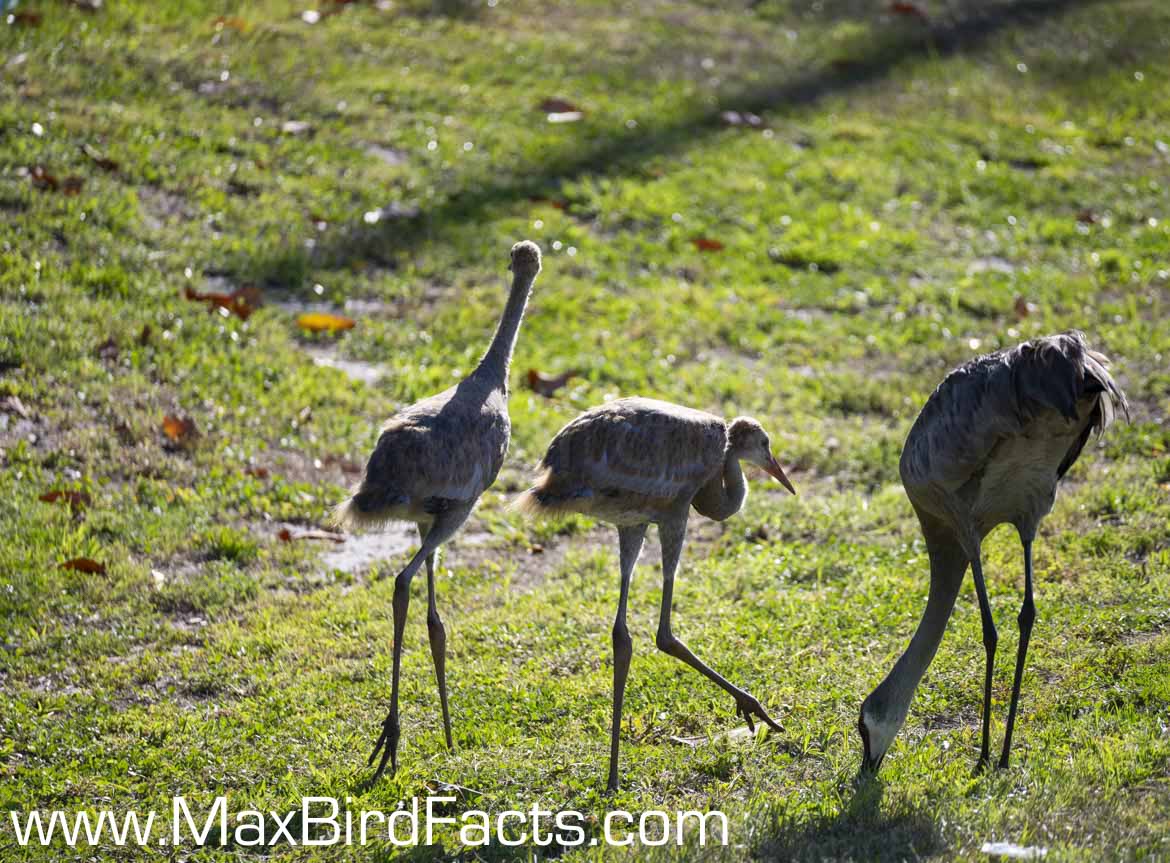
Sandhill Crane families will stay together for nearly a full year. Then, they will migrate north to their breeding grounds in Canada and Alaska, forming groups with other families and lone juveniles.
Once they reach the end of their migration, the parents will push the colt away to have another clutch in the same nest site they have used since their first season.
On their migration back south, the abandoned juveniles will form their own traveling groups.
After a few years, these cranes will find a mate, raise their colts, and repeat the cycle going for the past 100,000 years.
Protein isn't just for the colts; adult cranes need to eat bugs too.
Just like us, protein is a fundamental part of any animal's diet. Protein is the basis of muscle growth, maintenance, and repair.
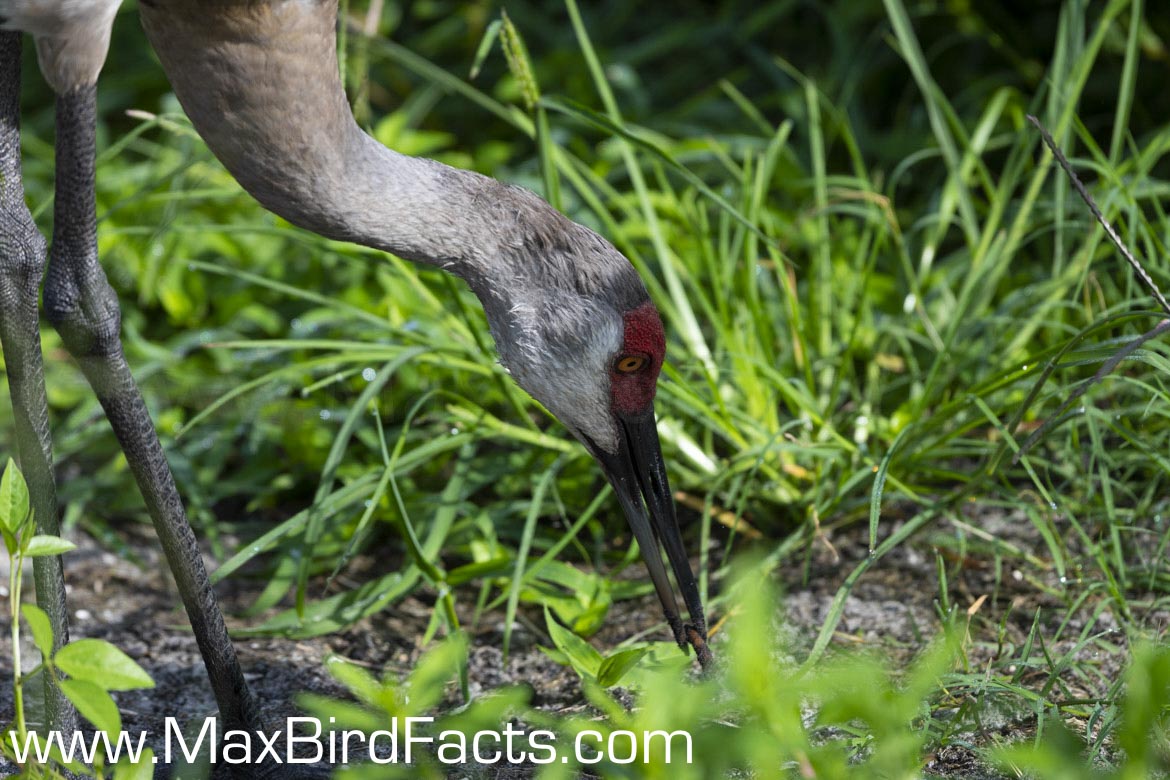
Needless to say, this 3,500-mile flight is going to have some significant strain on a crane's muscles. Consuming insects, frogs, lizards, snakes, small mammals, and even small birds or eggs will give these birds the needed protein to stay strong.
But, for the same reasons the chicks go after insects, the adults will prefer them.
Most insects poise a superficial risk to the birds but offer a splendid reward for their protein density.
Now We Know What Sandhill Cranes Eat
Just like any other bird, Sandhill Cranes aren't picky eaters, and they will gobble down just about anything they can swallow.
However, they are particularly fond of grains and insects. These two food sources give massive amounts of carbohydrates and protein, respectively, as we talked about above.
Sandhill Cranes have to travel from the southern border of the United States and Mexico into the northern reaches of Canada and Alaska. This odyssey of roughly 3,500 miles will be extremely taxing, and their holdover at the Platte River is vital to its success.
The spilled corn, soy, and wheat all give the birds a vast amount of available carbs.These carbohydrates are processed and recoup the crane's fat reserves to finish the last leg of their journey.
Insects are packed with protein, and that's just what a growing bird needs. Of course, all birds will eat bugs when they grow, but this is even more essential for precocial chicks.
Sandhill Cranes are walking around their nest site by the end of their first day, and by the time they are three months old, they will be flying.In only three months, the growth spurt from a six-inch colt to a four-foot crane is an incredible feat, and all of that wouldn't be possible without insect protein.
Adult cranes eat insects and other small animals for protein as well. They need the protein to keep their flight and leg muscles strong and healthy.
Sandhill Cranes are easily among my favorite birds. Their gray plumage, with the occasional rusty orange aspect and bright red skin on their face, is such an iconic look.
They have such a strange and beautiful call that is so different from any other bird I've heard. I have so many memories of listening to them bugle in the air and trying to spot the speck that is the crane.
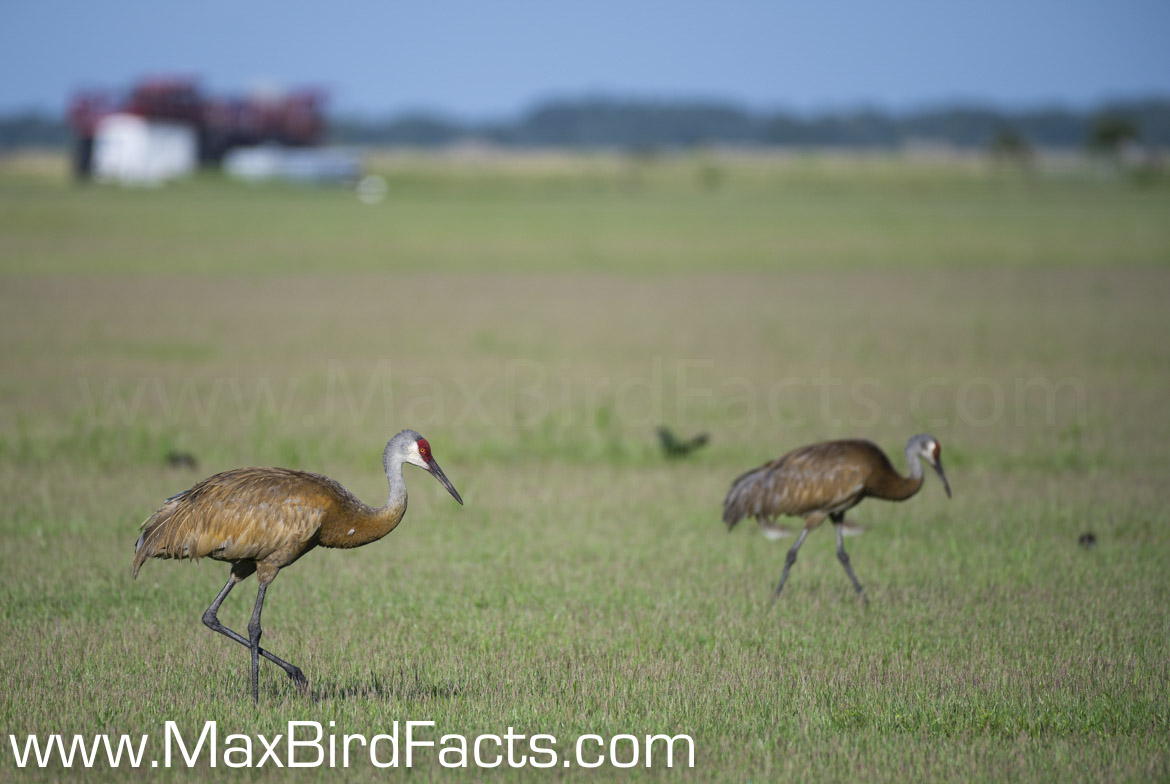
If you have any suggestions for future articles or topics you would like me to dive into, please leave a comment or shoot me an email.
Make today great!
Max
Source: https://maxbirdfacts.com/what-do-sandhill-cranes-eat-eating-bugs-for-growth/
0 Response to "What Can You Feed Wild Cranes"
Post a Comment